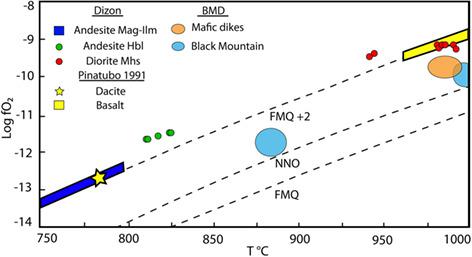菲律宾Dizon矿区与斑岩型铜金成矿有关的火成岩
IF 0.8
4区 地球科学
Q3 GEOLOGY
引用次数: 2
摘要
带富金斑岩铜矿,含铜0.67 Mt,金174 t,由闪长岩和安山岩斑岩侵入体赋存,成矿年代约2.5 Ma。用相对未蚀变岩石中的角闪孔和Fe - Ti氧化物评价了岩体的岩浆条件。闪长斑岩的母岩浆在~15 km深度为~950℃,安山岩斑岩的母岩浆温度较低,在~5 km深度为760 ~ 820℃。矿床形成于多次侵入的位置,有热基性岩浆注入的证据,包括斜长石斑晶的不稳定结构。Dizon的母岩浆被氧化,FMQ高于2.0,并且富含水,>5 wt%,与世界其他地方的许多大型斑岩矿床的条件相当。第带闪长斑岩中角闪孔厚不透明带的出现反映了岩浆中含水流体的释放;这些岩浆流体可能是该区斑岩矿床岩浆热液成矿的主要原因。斯卡伯勒海山的俯冲作用造成上覆板块的挤压作用,可能为成矿创造了有利的构造条件。本文章由计算机程序翻译,如有差异,请以英文原文为准。

Igneous rocks related to porphyry Cu‐Au mineralization at the Dizon mine, Philippines
The Dizon Au‐rich porphyry Cu deposit, 0.67 Mt Cu and 174 t Au, is hosted by diorite and andesite porphyry intrusions, dated at ~2.5 Ma. Amphibole and Fe‐Ti oxides in relatively unaltered rocks were used to evaluate the magma conditions of intrusions. Parental magma for diorite porphyry was ~950°C at a depth of ~15 km, whereas the parental magmas for the andesite porphyry had lower temperatures, 760–820°C at a depth of ~5 km. The deposit formed at the locus of multiple intrusions, with evidence for injections of hot mafic magmas, including destabilization texture of plagioclase phenocrysts. Parental magmas at Dizon were oxidized, above FMQ + 2.0, and water‐rich, >5 wt%, comparable to conditions of many large porphyry deposits elsewhere in the world. The occurrence of thick opacitic bands of amphibole in the diorite porphyry at Dizon reflects the release of aqueous fluids from the magma; such magmatic fluids were likely responsible for magmatic hydrothermal mineralization of the Dizon porphyry deposit. Subduction of the Scarborough Seamount caused a compressive regime in the overlying plate, which likely contributed to favourable tectonic conditions for mineralization.
求助全文
通过发布文献求助,成功后即可免费获取论文全文。
去求助
来源期刊

Resource Geology
地学-地质学
CiteScore
2.30
自引率
14.30%
发文量
18
审稿时长
12 months
期刊介绍:
Resource Geology is an international journal focusing on economic geology, geochemistry and environmental geology. Its purpose is to contribute to the promotion of earth sciences related to metallic and non-metallic mineral deposits mainly in Asia, Oceania and the Circum-Pacific region, although other parts of the world are also considered.
Launched in 1998 by the Society for Resource Geology, the journal is published quarterly in English, making it more accessible to the international geological community. The journal publishes high quality papers of interest to those engaged in research and exploration of mineral deposits.
 求助内容:
求助内容: 应助结果提醒方式:
应助结果提醒方式:


